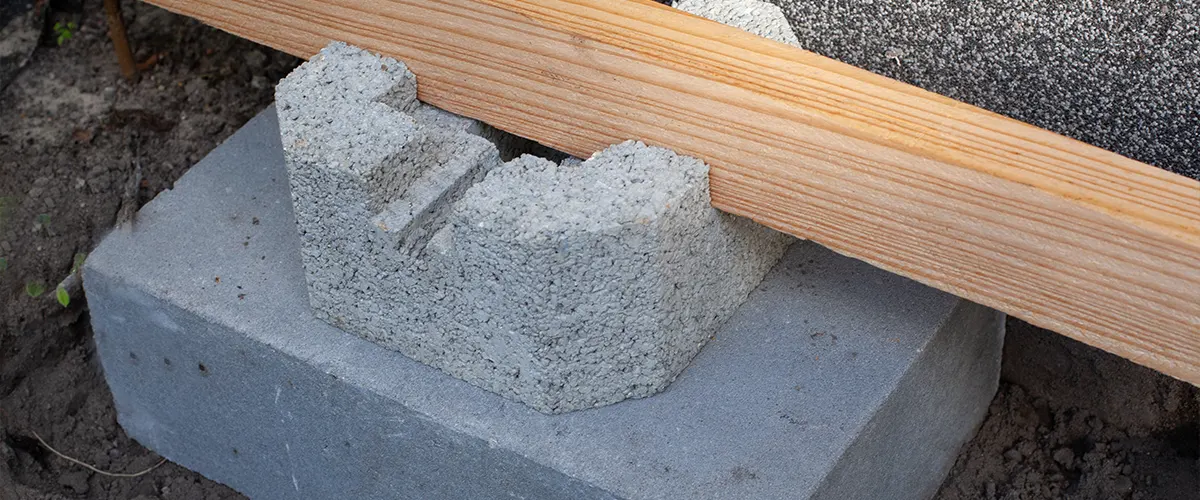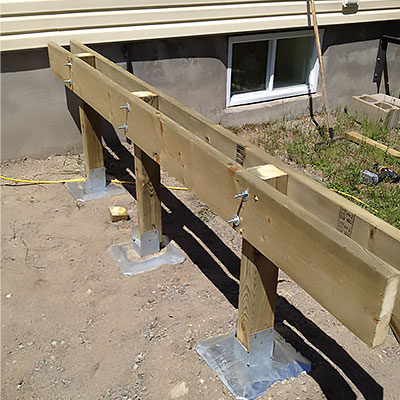Deck Footings Introduced: Understanding the Trick Components of a Trusted Deck Structure
Wiki Article
Choosing the Right Deck Footings for Security and Sturdiness
When it concerns constructing a deck, one of one of the most essential choices you will certainly make is picking the right grounds for stability and resilience. The long life and safety and security of your deck depend greatly on the kind of footings you pick, as they give the important support and stability to endure the test of time. With a myriad of options offered, it can be overwhelming to establish which footings are best matched for your details requirements. In this discussion, we will discover the different kinds of deck footings, take into consideration the crucial factors to consider when choosing, and explore the pros and disadvantages of different alternatives. By the end, you will have a more clear understanding of the choices handy and be better outfitted to make a notified decision for your deck task.Sorts Of Deck Grounds
These grounds consist of a cylindrical opening filled with concrete, which offers a strong structure for the deck articles. Concrete pier footings are relatively simple to mount and provide exceptional security, making them a preferred choice for numerous deck projects.These footings are mounted by screwing them right into the ground, which produces a safe structure for the deck. They likewise allow for very easy change and progressing of the deck if needed.
Alternatively, some home builders go with precast concrete grounds. These footings are made of sturdy concrete and be available in various forms and dimensions to accommodate various deck designs. Precast concrete grounds are practical to install and give a steady base for the deck framework.
Finally, an additional choice is the post-in-anchor ground system. This sort of footing entails driving a metal support into the ground and affixing it to the deck message. It supplies versatility in regards to positioning the deck blog posts and is appropriate for decks with light-weight structures.
When choosing the appropriate kind of deck footing, it is vital to consider aspects such as soil conditions, deck lots, and regional building regulations (Deck Footings). Consulting with a professional specialist or architectural designer can assist make certain the suitable ground is picked for a secure and safe deck
Aspects to Consider When Choosing Grounds
When picking the appropriate footings for a deck, it is vital to thoroughly think about numerous factors such as soil conditions, deck lots, and adherence to neighborhood building regulations. These aspects play a substantial role in making sure the security and sturdiness of the deck framework.Among the primary aspects to take into consideration is the soil conditions. The kind of dirt on which the deck will be developed identifies the kind of footings required. Decks built on sandy or loose soils may require deeper footings to supply ample assistance and prevent settling. On the other hand, decks improved clay or extensive soils might require grounds that can suit the dirt's tendency to expand and contract.
Another essential element is the deck lots. The weight of the deck, consisting of the products utilized and any type of potential live lots such as furnishings or gatherings, must be taken right into account when choosing footings. The grounds should be designed to birth the weight of the deck and distribute it evenly to avoid any kind of structural issues or failings.
Finally, adherence to local building regulations is vital. Building ordinance differ from region to area, and it is vital to adhere to the particular requirements established by the local authorities. Deck Footings. These codes ensure that the deck is constructed safely and meets the needed requirements for structural honesty and load-bearing capability
Concrete Grounds: Benefits And Drawbacks

Concrete grounds offer a number of advantages and downsides when used as the foundation for a deck. On the positive side, concrete grounds give excellent stability and longevity. Concrete is a strong and rigid product that can sustain hefty loads and endure numerous weather conditions. It likewise has a lengthy lifespan, making it a reputable selection for lasting usage.
An additional benefit of concrete grounds is their flexibility. They can be poured into different shapes and sizes to accommodate various deck designs and configurations. Concrete footings can be customized to fit the specific needs and needs of the deck framework.
However, there are also some downsides to using concrete footings. This can enhance the general expense of the deck task and might need professional aid.

Helical Piers Vs. Sonotubes: Which Is Better?
In thinking about the structure alternatives for a deck, the comparison between helical piers and sonotubes is important in establishing the superior option. Helical piers, likewise called screw piles, are steel shafts with helical plates try these out affixed to them. They are twisted into the ground utilizing hydraulic equipment, giving a long lasting and steady structure for the deck. On the various other hand, sonotubes are round kinds made of cardboard or fiber material that are full of concrete. They are positioned in a hole dug into the ground and supply assistance for the deck.When it involves security and toughness, helical piers have the upper hand. The helical plates on the piers create a solid hold with the soil, shifting or protecting against any kind of motion of the deck. This is especially beneficial in locations with unsteady or shifting dirt conditions. Sonotubes, on the other hand, rely only on the concrete filling up for stability, which might not supply the exact same level of toughness and resistance.
In regards to installation, helical piers are fairly easier and faster to set up compared to sonotubes. The hydraulic equipment used to turn the piers into the ground makes certain a fast and efficient procedure. Sonotubes, on the various other hand, require excavating openings and pouring concrete, which can be taxing and labor-intensive.
Additionally, helical piers are a more functional option. They can be made use of in numerous dirt problems and can be adjusted or enhanced if needed. Sonotubes, on the other hand, may require added assistance, such as rebar, in certain dirt conditions or areas with high lots requirements.
Choosing the Right Footings for Your Deck's Measurements
For optimum architectural honesty, it is vital to carefully select the suitable footings that line up with the measurements of your deck. The measurements of your deck, including its size, size, and elevation, play a substantial duty in determining the type and size of footings called for.When picking grounds for your deck, it is necessary to take into consideration the load-bearing ability of the soil. The weight of the deck, combined with the weight of any kind of furnishings or individuals on it, puts in a substantial pressure on visite site the grounds (Deck Footings). As a result, it is essential to choose grounds that can adequately support this weight without changing or sinking with time.
Bigger decks with better dimensions require larger grounds to provide sufficient security and support. The form of the grounds, whether they are square or rounded, depends on the layout and design of the deck.
Verdict
In final thought, choosing the right deck grounds is important for guaranteeing security and sturdiness. Factors such as the kind of footings, the deck's dimensions, and the benefits and drawbacks of different alternatives ought to be taken into consideration. Concrete footings use strength and long life, but might be much more pricey and time-consuming to mount. Helical piers and sonotubes have their own benefits and drawbacks. Inevitably, selecting the ideal footings for additional hints your deck's details needs is necessary for a lasting and effective structure.These grounds are composed of a cylindrical hole filled up with concrete, which gives a solid structure for the deck posts. Concrete pier footings are reasonably simple to mount and offer outstanding stability, making them a preferred option for several deck tasks.
Precast concrete footings are convenient to set up and give a steady base for the deck framework.
It supplies adaptability in terms of placing the deck posts and is ideal for decks with light-weight structures.
Concrete footings provide a number of advantages and downsides when made use of as the structure for a deck.
Report this wiki page